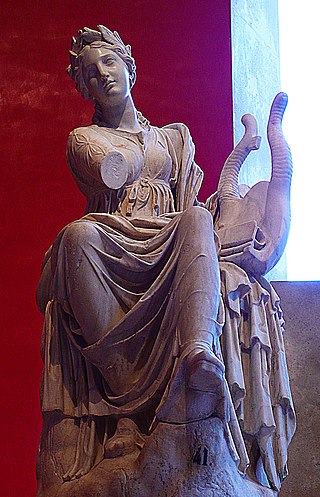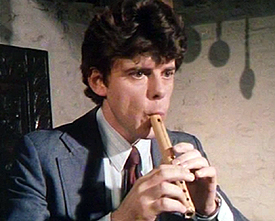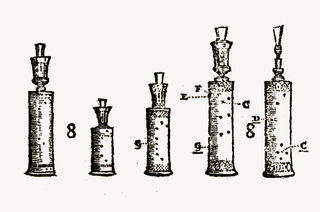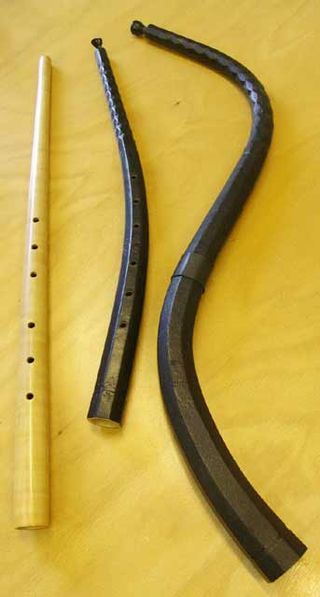
In Greek mythology, Terpsichore is one of the nine Muses and goddess of dance and chorus. She lends her name to the word "terpsichorean", which means "of or relating to dance".

The theorbo is a plucked string instrument of the lute family, with an extended neck that houses the second pegbox. Like a lute, a theorbo has a curved-back sound box with a flat top, typically with one or three sound holes decorated with rosettes. As with the lute, the player plucks or strums the strings with the right hand while "fretting" the strings with the left hand.

Michael Praetorius was a German composer, organist, and music theorist. He was one of the most versatile composers of his age, being particularly significant in the development of musical forms based on Protestant hymns.

David John Munrow was a British musician and early music historian.

The rackett, raggett, cervelas, or sausage bassoon is a Renaissance-era double reed wind instrument, introduced late in the sixteenth century and already superseded by bassoons at the end of the seventeenth century.

The kortholt is a musical instrument of the woodwind family, used in the Renaissance period.

The bassanello was a Renaissance double reed woodwind instrument which was described in 1619 by Michael Praetorius in his Syntagma Musicum II:

The tenor cornett or lizard was a common musical instrument in the Renaissance and Baroque periods. This instrument was normally built in C and the pedal (lowest) note of the majority of tenor cornetts was the C below middle C. A number of surviving instruments feature a key to secure the lowest note. The instrument has a useful range of approximately two and a half octaves, however, an experienced player with a strong embouchure may be able to push the instrument higher.
The Ceterone (Italian), was an enlarged cetera, believed to be similar to the chitarrone as a development of the chitarra and lute to enhance the bass capabilities of these instruments.

The lira da braccio was a European bowed string instrument of the Renaissance. It was used by Italian poet-musicians in court in the 15th and 16th centuries to accompany their improvised recitations of lyric and narrative poetry. It is most closely related to the medieval fiddle, or vielle, and like the vielle had a leaf-shaped pegbox with frontal pegs. Fiddles with drone strings are seen beginning in the 9th century, and the instrument continued to develop through the 16th century. In many depictions of the instrument, it is being played by mythological characters, frequently members of angel consorts, and most often by Orpheus and Apollo. The lira da braccio was occasionally used in ensembles, particularly in the intermedi, and may have acted as a proto-continuo instrument.

Bass violin is the modern term for various 16th- and 17th-century bass instruments of the violin family. They were the direct ancestor of the modern cello. Bass violins were usually somewhat larger than the modern cello, but tuned to the same nominal pitches or sometimes one step lower. Contemporaneous names for these instruments include "basso de viola da braccio," "basso da braccio," or the generic term "violone," which simply meant "large fiddle." The instrument differed from the violone of the viol, or "viola da gamba" family in that like the other violins it had at first three, and later usually four strings, as opposed to five, six, or seven strings, it was tuned in fifths, and it had no frets. With its F-holes and stylized C-bouts it also more closely resembled the viola da braccio.

The mandore is a musical instrument, a small member of the lute family, teardrop shaped, with four to six courses of gut strings and pitched in the treble range. Considered a French instrument, with much of the surviving music coming from France, it was used across "Northern Europe" including Germany and Scotland. Although it went out of style, the French instrument has been revived for use in classical music. The instrument's most commonly played relatives today are members of the mandolin family and the bandurria.
The sopranino recorder is the second smallest recorder of the modern recorder family, and was the smallest before the 17th century.
The alto recorder in F, also known as a treble (and, historically, as consort flute and common flute) is a member of the recorder family. Up until the 17th century the alto instrument was normally in G4 instead of F4. Its standard range is F4 to G6.

The bourrée is a dance of French origin and the words and music that accompany it. The bourrée resembles the gavotte in that it is in double time and often has a dactylic rhythm. However, it is somewhat quicker, and its phrase starts with a quarter-bar anacrusis or "pick-up", whereas a gavotte has a half-bar anacrusis.

Syntagma Musicum (1614-1620) is a musical treatise in three volumes by the German composer, organist, and music theorist Michael Praetorius. It was published in Wittenberg and Wolfenbüttel. It is one of the most commonly used research sources for seventeenth-century music theory and performance practice. The second volume, De Organographia, illustrates and describes musical instruments and their use; this volume in particular became a valuable guide for research and reconstruction of early instruments in the twentieth century, and thus an integral part of the early music revival. Though never published, Praetorius intended to write a fourth volume on musical composition.
The garklein recorder in C, also known as the sopranissimo recorder or piccolo recorder, is the smallest size of the recorder family. Its range is C6–A7 (C8). The name garklein is German for "quite small", and is also sometimes used to describe the sopranino in G. Although some modern German makers use the single-word form Garkleinflötlein, this is without historical precedent. Double holes for the two lowest notes (used on the larger recorders to achieve a fully chromatic scale) are uncommon. The instrument is usually notated in the treble clef two octaves lower than its actual sound. The garklein recorder is only about 16 to 18 cm long and is different from larger recorders in that it is usually made in one piece due to its size.

A bass recorder is a wind instrument in F3 that belongs to the family of recorders.
The penorcon is a plucked string instrument with nine courses of double strings, depicted in the treatise Syntagma Musicum by Praetorius. The sides of the instrument are scalloped and sometimes the resonance soundboard has no holes. In relation to the bandora, its body is a little broader, and in length, it is somewhat lesser. Its neck or fingerboard is quite wide.

Jeffery T. Kite-Powell is an American musicologist and professor emeritus at the Florida State University College of Music where he was active from 1984 to 2013. During his tenure at FSU, he was coordinator of the Music History and Musicology Division from 1996 to 2008. He also directed the Florida State University early music ensembles and in 1989 he founded the vocal group Cantores Musicæ Antiquæ. Kite-Powell's primary focuses are the music of the Renaissance and early Baroque periods, organ tablature, historical performance practice, and Michael Praetorius.















